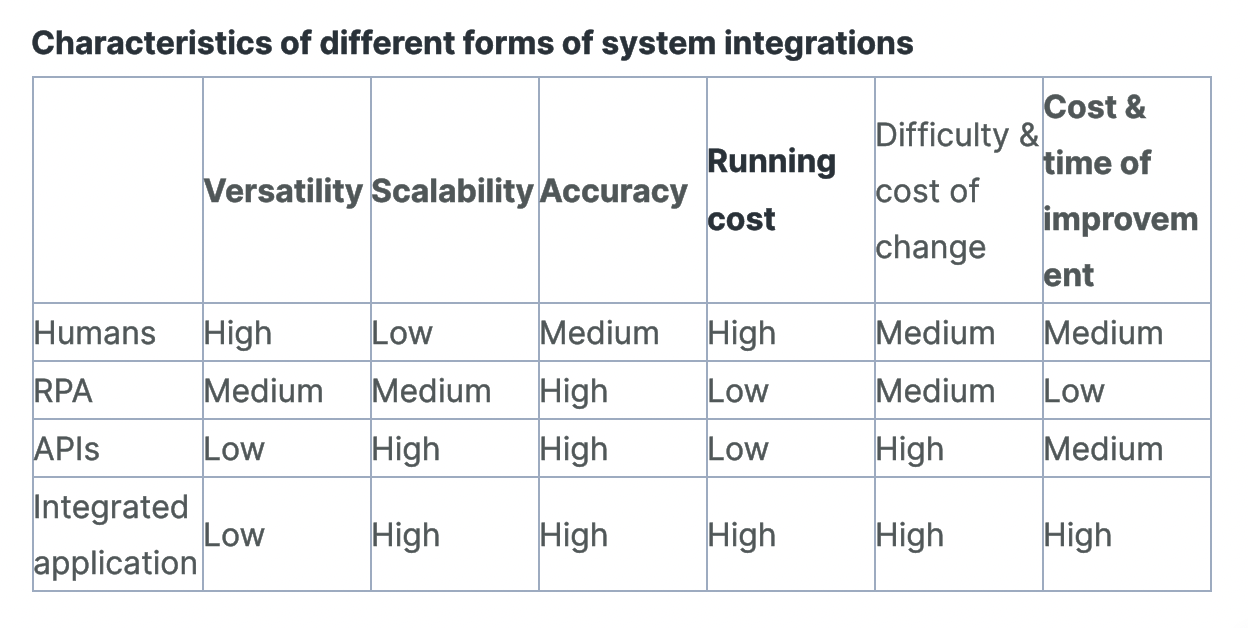Why RPA is an Ideal Technology to Integrate Legacy Systems
Share at:

You may have heard Robotic Process Automation (RPA) described by some as a temporary, Band-Aid solution. In the past, those same critics deemed the user interface (UI) integration as brittle and subject to the vagaries of the simplest look and feel change in the underlying applications.
There was a kernel of truth to this argument but things are changing fast.
Today, the UiPath Platform and technology are more advanced than even a couple of months ago. The UI does not rely solely on traditional screen scrapping techniques of the past. Currently, our technology uses more sophisticated techniques such as computer vision that makes software robots able to understand the information displayed on a screen more robustly. Robots are also less impacted by minor changes.
Having said that, RPA needs to be evaluated against other approaches to integration as this is not a ‘either or’ situation but rather a continuum set of approaches to integration.

As we can see from the table above, RPA is more flexible, faster, and cheaper to deploy than APIs or integrated applications. APIs and integrated applications tend to be better suited for high-volume transactions but carry much higher costs of deployment and offer less flexibility.
Furthermore, many organizations still have a large inventory of green screen, mainframe legacy applications that cannot be integrated through API and for which RPA is the ideal solution.
Finally, people underestimate the costs related to change. Any business process outsourcing (BPO) vendor or large organization knows that training humans to run processes differently (and at scale) is expensive and time consuming. In addition to being error prone. Readjusting an RPA script is comparatively cheap.
RPA is a new enterprise application that is necessary in the overall ‘tool kit’ of a chief information officer (CIO) as they think of their entire system landscape.
As business models and needs tend to change ever faster, it is becoming increasingly difficult to rely solely on 'elegant' system architectures made of fully integrated applications to keep up with the needs of business. These tend to be costly to deploy and are often obsolete by the time they are fully implemented.
The reality is that over the past decades, companies have been automating clerical work mainly according to functions (e.g. finance, human resources, customer relations) using specialized full stack applications that were deployed by specialized IT departments. However, digitally native competitors have raised the bar of user experience by focusing on customers key processes. This evolution requires a 'process' orientation to digitization from organizations across their legacy function-based information systems.
To offer such 'process-oriented digitization,' organizations and IT departments need a set of technologies that will allow them to create fast and process automations cost effectively with the participation of business users themselves.
By further integrating artificial intelligence (AI) and API management, the UiPath Platform has become the ideal tool for providing a relatively fast 'born native' customer experience built on top of legacy systems. The platform offers a robust set of capabilities from the UI integration capability sustained by UiPath AI Computer Vision. In addition, UiPath provides less-technical users the ability to build 'simple' low-code/no-code automated workflows simultaneously leveraging robots and APIs.
As a testimony to the increasingly strategic importance of RPA, in a 2019 KPMG survey of 740 global business leaders, RPA was ranked as the second most important technology for business transformation (ahead of AI)!
To conclude, RPA is far from a Band-Aid technology. It is a foundational strategic tool that allows organizations to answer today’s business imperatives in a cost-effective way.
Want to know more? Get your free copy of our new guide Identifying the Real Business Value of RPA.

President of the Board, UiPath Foundation
Get articles from automation experts in your inbox
SubscribeGet articles from automation experts in your inbox
Sign up today and we'll email you the newest articles every week.
Thank you for subscribing!
Thank you for subscribing! Each week, we'll send the best automation blog posts straight to your inbox.



